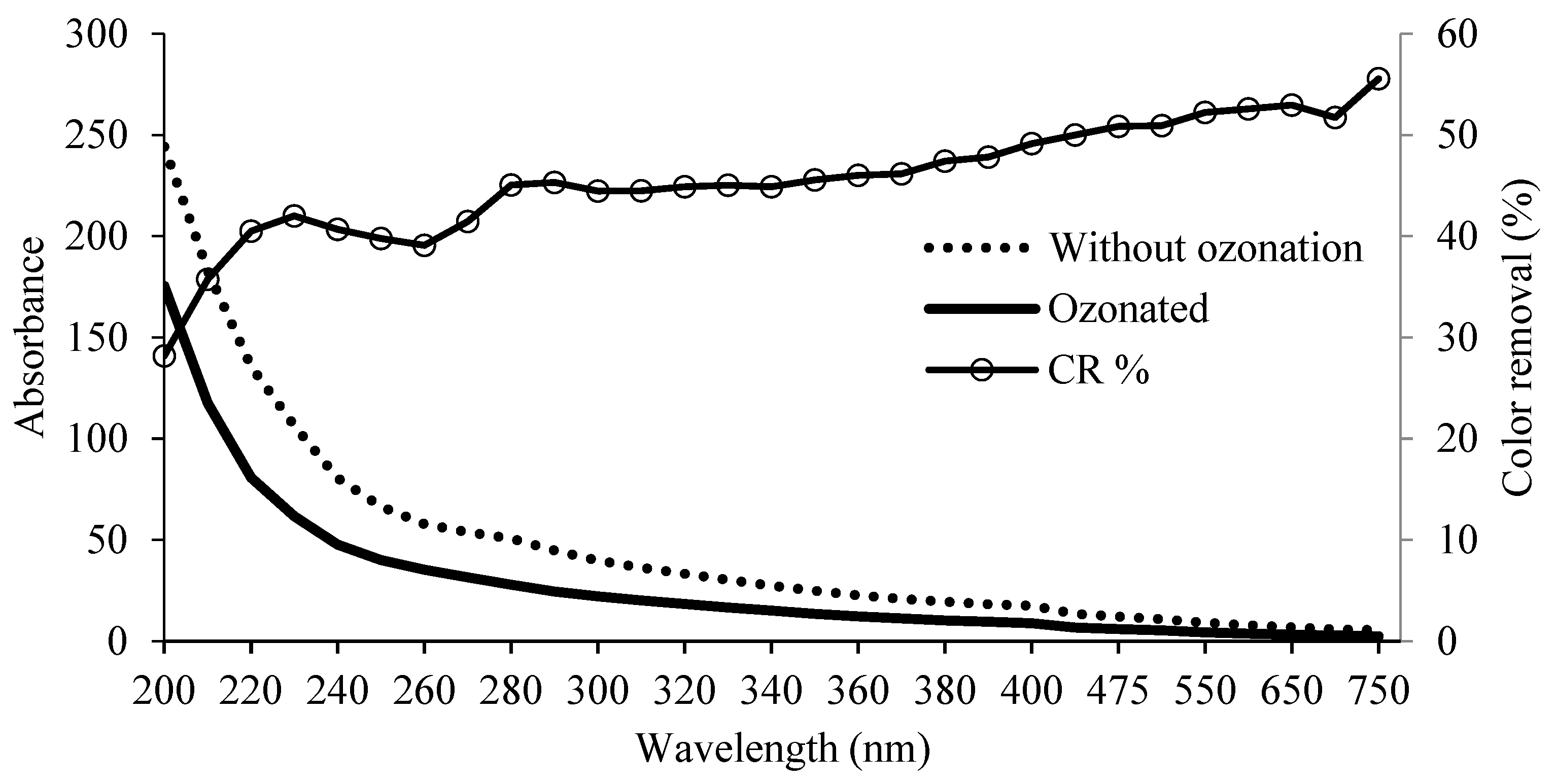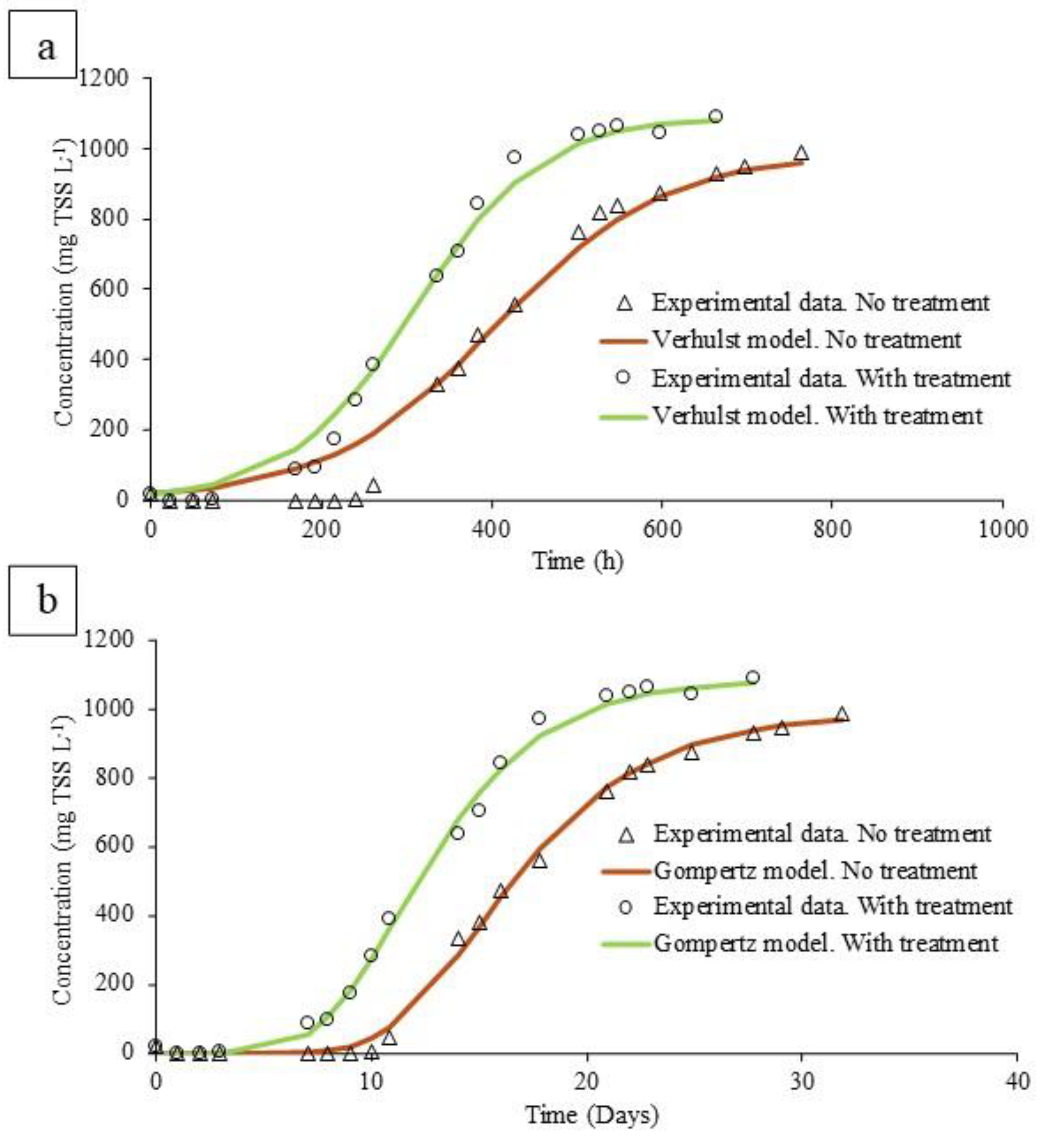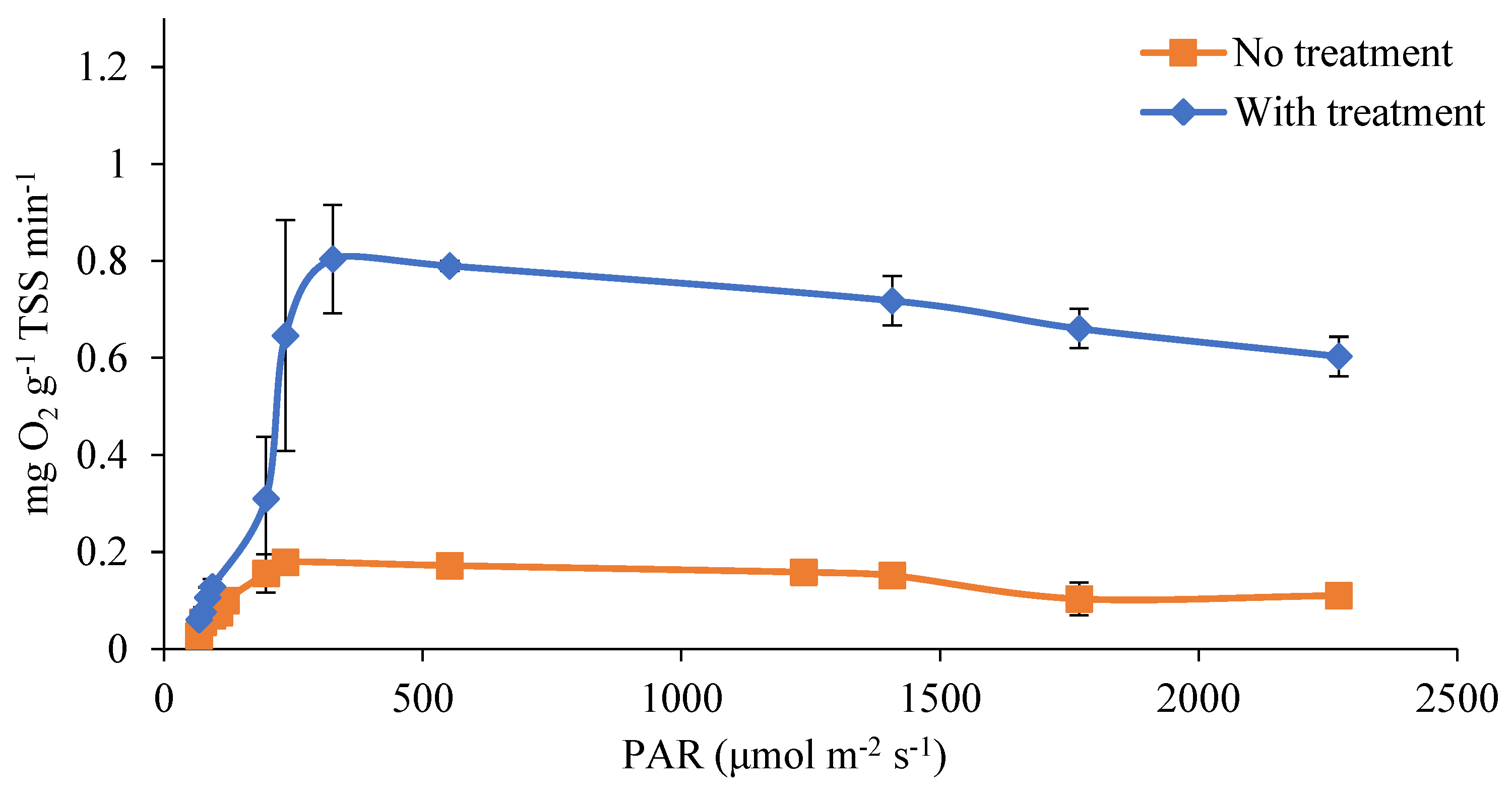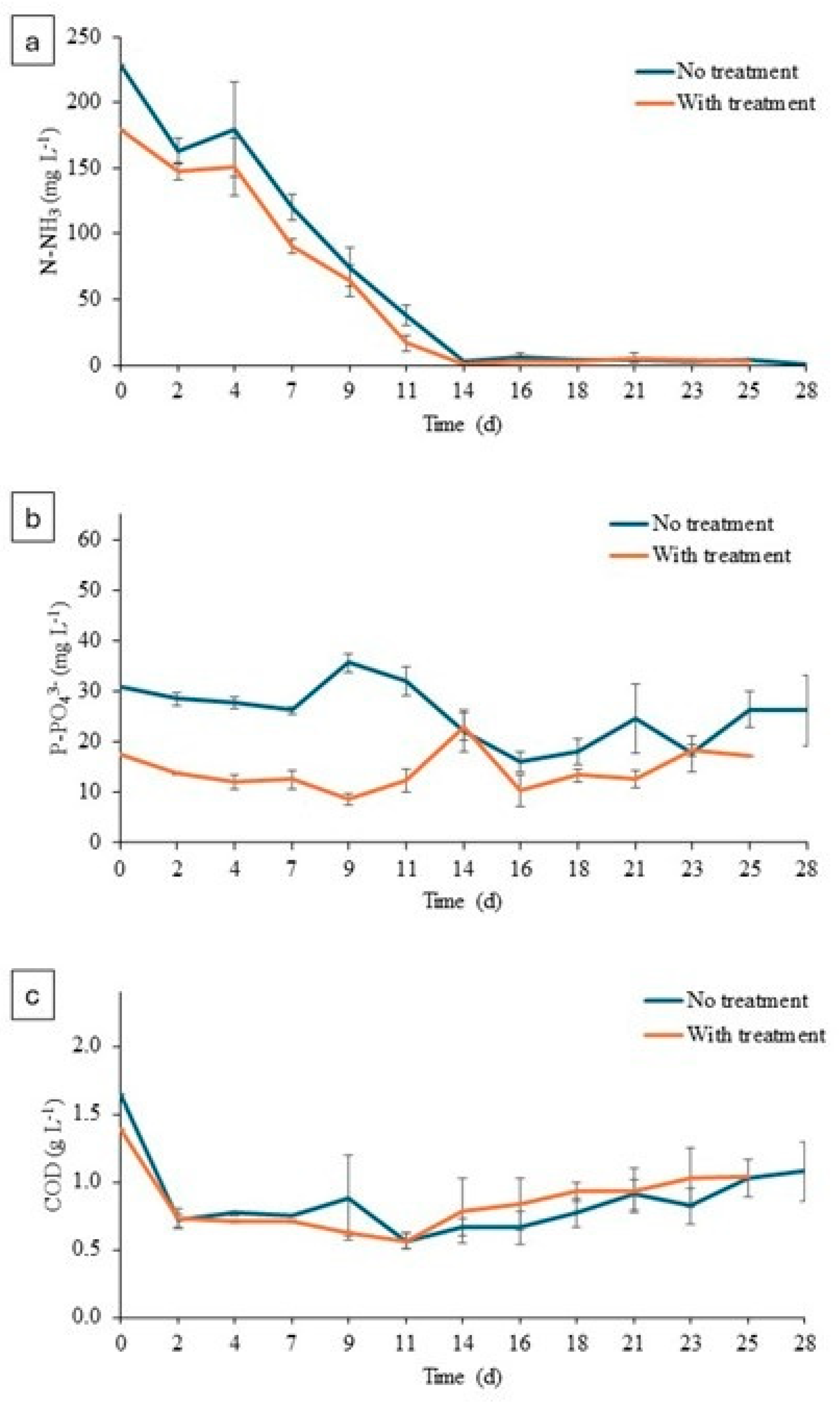Ozonation as Pretreatment of Digested Swine Manure Prior to Microalgae Culture
Abstract
1. Introduction
2. Materials and Methods
2.1. Digestate and Ozonation System
2.2. Microalgae Culture System
2.3. Digestate Ozonation
2.4. Microalgae Growth Tests
2.5. Light Response Tests
2.6. Analytical Procedures
3. Results and Discussion
3.1. Digestate Analysis
3.2. Microalgae Growth Monitoring Tests
3.3. Light Response Test
3.4. Nutrient Removal
4. Conclusions
Supplementary Materials
Author Contributions
Funding
Data Availability Statement
Acknowledgments
Conflicts of Interest
Acronym and Symbol List
| Acronym | Symbol | Meaning | |
| Af | Absorbance final | μmol | Photon micromoles |
| Ai | Absorbance initial | min | Minutes |
| COD | Chemical oxygen demand | mg | Milligrams |
| CR | Color removal | L | Liters |
| DO | Dissolved oxygen | h | Hours |
| GR | Growth rate | nm | Nanometers |
| LED | Light emitting diode | °C | Degrees Celsius |
| NTK | Total nitrogen Kjeldahl | Xo | Initial biomass concentration |
| PAR | Photosynthetically active radiation | Xm | Final biomass concentration |
| RPM | Revolutions per minute | λ | Delay phase |
| Td | Time delay | Af | Absorbance final |
| TOC | Total organic carbon | Ai | Absorbance initial |
| TSS | Total suspended solids | g | Grams |
| UV | Ultra violet | Wh | Watt hours |
| s | Seconds | ||
| m | meters |
References
- Ardakani, Z.; Aragrande, M.; Canali, M. Global antimicrobial use in livestock farming: An estimate for cattle, chickens, and pigs. Animal 2024, 18, 101060. [Google Scholar] [CrossRef] [PubMed]
- Luo, Z.; Wang, D.; Zeng, W.; Yang, J. Removal of refractory organics from piggery bio-treatment effluent by the catalytic ozonation process with piggery biogas residue biochar as the catalyst. Sci. Total Environ. 2020, 734, 139448. [Google Scholar] [CrossRef]
- Liu, L.; Lin, X.; Luo, L.; Yang, J.; Luo, J.; Liao, X.; Cheng, H. Biosorption of copper ions through microalgae from piggery digestate: Optimization, kinetic, isotherm and mechanism. J. Clean. Prod. 2021, 319, 128724. [Google Scholar] [CrossRef]
- Saranya, D.; Shanthakumar, S. An integrated approach for tannery effluent treatment with ozonation and phycoremediation: A feasibility study. Environ. Res. 2020, 183, 109163. [Google Scholar] [CrossRef]
- Saranya, D.; Shanthakumar, S. Effect of culture conditions on biomass yield of acclimatized microalgae in ozone pre-treated tannery effluent: A simultaneous exploration of bioremediation and lipid accumulation potential. J. Environ. Manag. 2020, 273, 111129. [Google Scholar] [CrossRef] [PubMed]
- Joshi, N.C.; Rawat, B.S.; Kumar, P.; Kumar, N.; Upadhyay, S.; Chetana, S.; Gururani, P.; Kimothi, S. Sustainable synthetic approach and applications of ZnO/r-GO in the adsorption of toxic Pb2+ and Cr6+ ions. Inorg. Chem. Commun. 2022, 145, 110040. [Google Scholar] [CrossRef]
- Joshi, N.C.; Gururani, P. A mini review on heavy metal contamination in vegetable crops. Int. J. Environ. Anal. Chem. 2023, 1–12. [Google Scholar] [CrossRef]
- Joshi, S.M.; Gogate, P.R. Treatment of landfill leachate using different configurations of ultrasonic reactors combined with advanced oxidation processes. Sep. Purif. Technol. 2019, 211, 10–18. [Google Scholar] [CrossRef]
- Lofrano, G.; Meriç, S.; Zengin, G.E.; Orhon, D. Chemical and biological treatment technologies for leather tannery chemicals and wastewaters: A review. Sci. Total Environ. 2013, 461–462, 265–281. [Google Scholar] [CrossRef] [PubMed]
- Quan, X.; Hu, R.; Chang, H.; Tang, X.; Huang, X.; Cheng, C.; Zhong, N.; Yang, L. Enhancing microalgae growth and landfill leachate treatment through ozonization. J. Clean. Prod. 2020, 248, 119182. [Google Scholar] [CrossRef]
- de Godos, I.; Vargas, V.A.; Blanco, S.; González, M.C.; Soto, R.; García-Encina, P.A.; Becares, E.; Muñoz, R. A comparative evaluation of microalgae for the degradation of piggery wastewater under photosynthetic oxygenation. Bioresour. Technol. 2010, 101, 5150–5158. [Google Scholar] [CrossRef] [PubMed]
- De Godos, I.; Blanco, S.; García-Encina, P.A.; Becares, E.; Muñoz, R. Long-term operation of high rate algal ponds for the bioremediation of piggery wastewaters at high loading rates. Bioresour. Technol. 2009, 100, 4332–4339. [Google Scholar] [CrossRef] [PubMed]
- Guieysse, B.; Béchet, Q.; Shilton, A. Variability and uncertainty in water demand and water footprint assessments of fresh algae cultivation based on case studies from five climatic regions. Bioresour. Technol. 2012, 128C, 317–323. [Google Scholar] [CrossRef] [PubMed]
- Rekhate, C.V.; Srivastava, J.K. Recent advances in ozone-based advanced oxidation processes for treatment of wastewater—A review. Chem. Eng. J. Adv. 2020, 3, 100031. [Google Scholar] [CrossRef]
- John; Brookes, A.; Carra, I.; Jefferson, B.; Jarvis, P. Microbubbles and their application to ozonation in water treatment: A critical review exploring their benefit and future application. Crit. Rev. Environ. Sci. Technol. 2022, 52, 1561–1603. [Google Scholar] [CrossRef]
- Merayo, N.; Hermosilla, D.; Blanco, L.; Cortijo, L.; Blanco, Á. Assessing the application of advanced oxidation processes, and their combination with biological treatment, to effluents from pulp and paper industry. J. Hazard. Mater. 2013, 262, 420–427. [Google Scholar] [CrossRef] [PubMed]
- Ibrahim, F.G.G.; Gómez, V.A.; Torre, R.M.; de Godos Crespo, I. Scale-down of high-rate algae ponds systems for urban wastewater reuse. J. Water Process Eng. 2023, 56, 104342. [Google Scholar] [CrossRef]
- Duffie, J.A.; Beckman, W.A.; McGowan, J. Solar Engineering of Thermal Processes. Am. J. Phys. 1985, 53, 382. [Google Scholar] [CrossRef]
- Depraetere, O.; Foubert, I.; Muylaert, K. Decolorisation of piggery wastewater to stimulate the production of Arthrospira platensis. Bioresour. Technol. 2013, 148, 366–372. [Google Scholar] [CrossRef] [PubMed]
- Costache, T.A.; Acien Fernandez, F.G.; Morales, M.M.; Fernández-Sevilla, J.M.; Stamatin, I.; Molina, E. Comprehensive model of microalgae photosynthesis rate as a function of culture conditions in photobioreactors. Appl. Microbiol. Biotechnol. 2013, 97, 7627–7637. [Google Scholar] [CrossRef] [PubMed]
- Frunzo, L.; Garra, R.; Giusti, A.; Luongo, V. Modeling biological systems with an improved fractional Gompertz law. Commun. Nonlinear Sci. Numer. Simul. 2019, 74, 260–267. [Google Scholar] [CrossRef]
- De Lauro, E.; De Martino, S.; De Siena, S.; Giorno, V. Stochastic roots of growth phenomena. Phys. A Stat. Mech. Its Appl. 2014, 401, 207–213. [Google Scholar] [CrossRef]
- Barreiro-Vescovo, S.; González-Fernández, C.; Ballesteros, M.; de Godos, I. Activity determination of an algal-bacterial consortium developed during wastewater treatment based on oxygen evolution. J. Water Process Eng. 2020, 36, 101278. [Google Scholar] [CrossRef]
- Apha. Standard Methods for the Examination of Water and Wastewater; Apha: Cincinnati, OH, USA, 1985. [Google Scholar]
- Álvaro, A.G.; Palomar, C.R.; Valenzuela, E.I.; Redondo, D.H.; Torre, R.M.; de Godos Crespo, I. Microbial analysis of anaerobic digester reveals prevalence of manure microbiota. J. Water Process Eng. 2024, 60, 105162. [Google Scholar] [CrossRef]
- Kim, H.C.; Choi, W.J.; Maeng, S.K.; Kim, H.J.; Kim, H.S.; Song, K.G. Ozonation of piggery wastewater for enhanced removal of contaminants by S. quadricauda and the impact on organic characteristics. Bioresour. Technol. 2014, 159, 128–135. [Google Scholar] [CrossRef] [PubMed]
- Magara, Y.; Itoh, M.; Morioka, T. Application of ozone to water treatment and power consumption of ozone generating systems. Progress Nucl. Energy 1995, 29, 175–182. [Google Scholar] [CrossRef]
- Jodzis, S.; Zięba, M. Energy efficiency of an ozone generation process in oxygen. Analysis of a pulsed DBD system. Vacuum 2018, 155, 29–37. [Google Scholar] [CrossRef]
- Tripathi, P.; Tiwari, S.; Tiwari, H.; Sonwani, R.K.; Singh, R.S. Techno-economic assessment of coupling ozonation and biodegradation process for the dye wastewater treatment. J. Water Process Eng. 2023, 56, 104286. [Google Scholar] [CrossRef]
- Das, C.; Ramaiah, N.; Pereira, E.; Naseera, K. Efficient bioremediation of tannery wastewater by monostrains and consortium of marine Chlorella sp. and Phormidium sp. Int. J. Phytoremed. 2018, 20, 284–292. [Google Scholar] [CrossRef]
- Al-Mallahi, J.; Ishii, K. Attempts to alleviate inhibitory factors of anaerobic digestate for enhanced microalgae cultivation and nutrients removal: A review. J. Environ. Manag. 2022, 304, 114266. [Google Scholar] [CrossRef]
- Uggetti, E.; Sialve, B.; Latrille, E.; Steyer, J.P. Anaerobic digestate as substrate for microalgae culture: The role of ammonium concentration on the microalgae productivity. Bioresour. Technol. 2014, 152, 437–443. [Google Scholar] [CrossRef] [PubMed]
- Al-Mallahi, J.; Ishii, K.; Sato, M.; Ochiai, S. Static supply of different simulated flue gases for native microalgae cultivation in diluted cow manure digestate. J. Environ. Manag. 2023, 335, 117557. [Google Scholar] [CrossRef] [PubMed]
- Depurador Húmedo. Available online: https://www.kairos-engineering.it/en/ozone-generator (accessed on 27 March 2024).
- Fabricante de Equipos de Ozono e Integradores de Sistemas de Ozono Póngase en Contacto con Oxidation Technologies Ozone Integration Experts. Available online: https://www.oxidationtech.com/contact-us-101.html (accessed on 27 March 2024).
- Ozone Generators–Lenntech. Available online: https://www.lenntech.com/otozone.htm (accessed on 27 March 2024).
- Riaño, B.; Coca, M.; García-González, M.C. Evaluation of Fenton method and ozone-based processes for colour and organic matter removal from biologically pre-treated swine manure. Chemosphere 2014, 117, 193–199. [Google Scholar] [CrossRef] [PubMed]
- de Godos, I.; Arbib, Z.; Lara, E.; Cano, R.; Muñoz, R.; Rogalla, F. Wastewater treatment in algal systems. In Innovative Wastewater Treatment & Resource Recovery Technologies: Impacts on Energy, Economy and Environment; International Water Association: London, UK, 2017; pp. 76–95. [Google Scholar] [CrossRef]
- Jeon, Y.C.; Cho, C.W.; Yun, Y.S. Oxygen evolution rate of photosynthetic microalga Haematococcus pluvialis depending on light intensity and quality. Stud. Surf. Sci. Catal. 2006, 159, 157–160. [Google Scholar] [CrossRef]
- Ayre, J.M.; Moheimani, N.R.; Borowitzka, M.A. Growth of microalgae on undiluted anaerobic digestate of piggery effluent with high ammonium concentrations. Algal Res. 2017, 24, 218–226. [Google Scholar] [CrossRef]
- Kendir, S.; Franzreb, M. Synergies of pH-induced calcium phosphate precipitation and magnetic separation for energy-efficient harvesting of freshwater microalgae. Bioresour. Technol. 2024, 391, 129964. [Google Scholar] [CrossRef] [PubMed]
- Sukenik, A.; Shelef, G. Algal autoflocculation—Verification and proposed mechanism. Biotechnol. Bioeng. 1984, 26, 142–147. [Google Scholar] [CrossRef] [PubMed]






| Sample | Untreated Digestate | Digestate Treated |
|---|---|---|
| CR (%) 475 nm | 0.00 | 50.83 |
| COD (g L−1) | 13.50 ± 4.53 | 10.35 ± 4.29 |
| C (g L−1) | 15.1 ± 4,96 | - |
| N-NH4+/N-NH3 (g L−1) | 2.10 ± 2.33 | 2.02 ± 1.96 |
| NTK (g L−1) | 2.13 ± 0.12 | 2.24 ± 0.12 |
| Ammonia (%) | 98.69 | 90.00 |
| N-NO2− (mg L−1) | 14.19 ± 7.82 | 12.22 ± 8.64 |
| N-NO3− (mg L−1) | 0.00 ± 0.00 | 49.82 ± 5.60 |
| P-PO43− (mg L−1) | 185.84 ± 3.05 | 95.11 ± 3.05 |
| pH | 7.65 ± 0.44 | 8.27 ± 0.00 |
| No Treatment | With Treatment | % Increase | ||
|---|---|---|---|---|
| Gompertz | Xo (mgTSS L−1) | 17.28 | 17.27 | - |
| Xm (mgTSS L−1) | 986.46 | 1089.61 | 10.46 | |
| GR (mg TSS L−1 d−1) | 84.52 | 107.20 | 26.83 | |
| λ (d) | 10.64 | 7.45 | - | |
| R2 | 0.998 | 0.997 | - | |
| Verhulst | Xo (mgTSS L−1) | 17.28 | 17.27 | - |
| Xm (mgTSS L−1) | 986.46 | 1089.61 | 10.46 | |
| GR (mg TSS L−1 d−1) | 54.39 | 78.56 | 44.44 | |
| R (d−1) | 0.010 | 0.013 | - | |
| Td (d) | 2.90 | 2.16 | - | |
| R2 | 0.970 | 0.991 | - |
Disclaimer/Publisher’s Note: The statements, opinions and data contained in all publications are solely those of the individual author(s) and contributor(s) and not of MDPI and/or the editor(s). MDPI and/or the editor(s) disclaim responsibility for any injury to people or property resulting from any ideas, methods, instructions or products referred to in the content. |
© 2024 by the authors. Licensee MDPI, Basel, Switzerland. This article is an open access article distributed under the terms and conditions of the Creative Commons Attribution (CC BY) license (https://creativecommons.org/licenses/by/4.0/).
Share and Cite
Palomar, C.R.; Álvaro, A.G.; Hermosilla, D.; Gascó, A.; Muñoz, R.; de Godos, I. Ozonation as Pretreatment of Digested Swine Manure Prior to Microalgae Culture. Water 2024, 16, 1740. https://doi.org/10.3390/w16121740
Palomar CR, Álvaro AG, Hermosilla D, Gascó A, Muñoz R, de Godos I. Ozonation as Pretreatment of Digested Swine Manure Prior to Microalgae Culture. Water. 2024; 16(12):1740. https://doi.org/10.3390/w16121740
Chicago/Turabian StylePalomar, César Ruiz, Alfonso García Álvaro, Daphne Hermosilla, Antonio Gascó, Raúl Muñoz, and Ignacio de Godos. 2024. "Ozonation as Pretreatment of Digested Swine Manure Prior to Microalgae Culture" Water 16, no. 12: 1740. https://doi.org/10.3390/w16121740
APA StylePalomar, C. R., Álvaro, A. G., Hermosilla, D., Gascó, A., Muñoz, R., & de Godos, I. (2024). Ozonation as Pretreatment of Digested Swine Manure Prior to Microalgae Culture. Water, 16(12), 1740. https://doi.org/10.3390/w16121740









